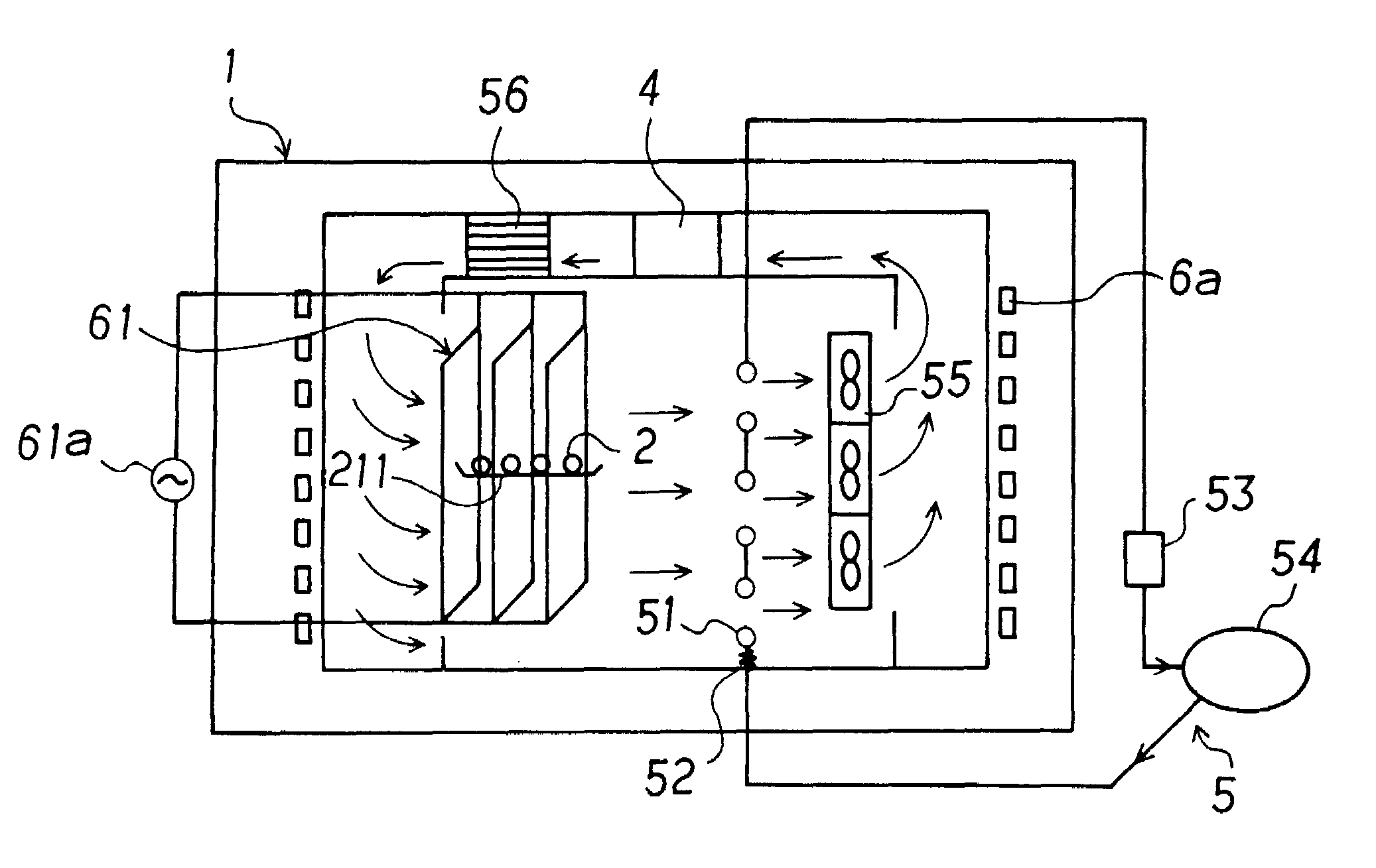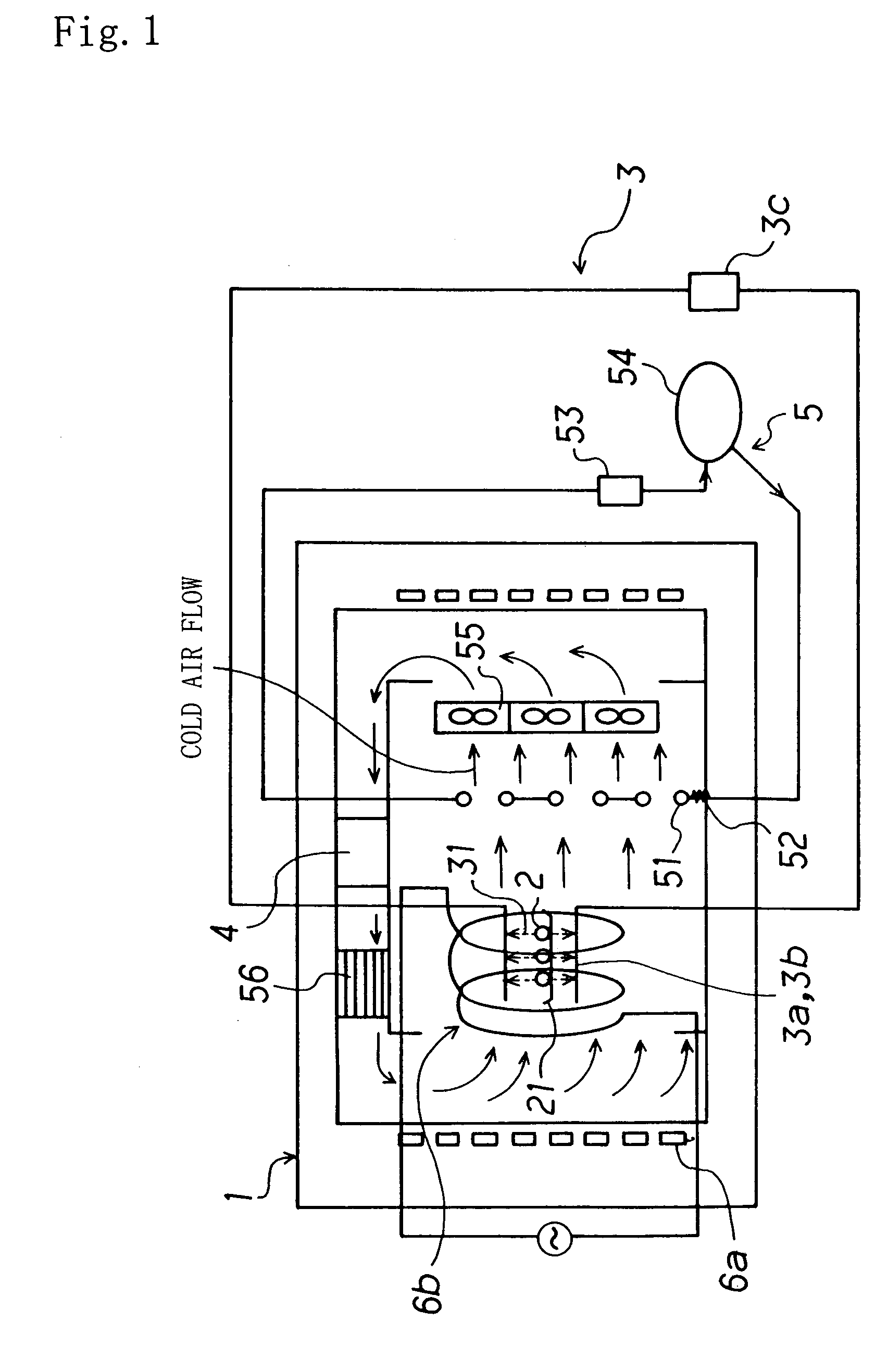Highly-efficient freezing apparatus and highly-efficient freezing method
a technology of high-efficiency freezing and equipment, which is applied in the direction of domestic cooling equipment, lighting and heating equipment, heating types, etc., can solve the problems of affecting the quality of frozen materials, so as to prevent the coarseness of ice crystals and the destruction of cells, the effect of preventing the destruction of cells
- Summary
- Abstract
- Description
- Claims
- Application Information
AI Technical Summary
Benefits of technology
Problems solved by technology
Method used
Image
Examples
example 1
[0125]In use of the rack-type freezer shown in FIG. 1 being the high-functional freezing apparatus of the present invention, raw chicken meat and tuna fish placed as the objects 2 on the holder 21 and accomodated in the internal space of the freezer 1 were frozen by being subjected to the action of the freezing means 5. The internal walls of the freezer 1 were provided with a material capable of absorbing far infrared rays, silica-alumina-iron oxide ceramic in this example. The specifications of the freezing apparatus used were: dimensions, 1.5 m in height by 1.5 m in width by 2.5 m in length; freezing compressor, 10 HP; cooling medium, R22.
[0126]For freezing, the oscillating electric field-generating means 3 applied an oscillating electric field; further a permanent magnet serving as the static magnetic field-generating means 6a and a dielectric coil serving as the variable magnetic field-generating means 6b applied a static magnetic field and a variable magnetic field; further the...
example 2
[0137]A variable magnetic field was generated with a uniform variable magnetic field generator including the electromagnetic coil units 61 disposed in parallel in the longitudinal direction of the rack-type holder 211, as shown in FIG. 4. Four electromagnetic coil units 61 were disposed in parallel in the longitudinal direction of the rack-type holder 211. Each electromagnetic coil unit 61 comprised a rectangular ring-shaped plastic base 611 of 1.2 m in length by 0.7 m in width, having a case-like, U-shaped section with a bore-size of 4 cm×4 cm and an electromagnetic coil 612 formed of 600 turns of copper wire 612a coated with a polyimide resin, wound around the coil base. The electromagnetic coil 612 was subjected to caulking. Then, a cover was bonded to the case-shaped base with an adhesive and, thus, the electromagnetic coil unit containing the electromagnetic coil was completed.
[0138]A coil current of 1 A being an alternating current with a commercial frequency of 50 Hz was pass...
example 3
[0143]A variable magnetic field was generated with a uniform variable magnetic field generator including a plurality of electromagnetic coil units 61 disposed in parallel in the moving direction of the holder (net conveyer belt 212), as shown in FIG. 5. Electromagnetic coil units 61 were disposed above and below the net conveyer belt 212 of 1 m in width by 10 m in length so that each member of a pair of the electromagnetic coil units is separated by the net conveyer belt 212 with a distance of 10 cm from the net conveyer belt 212. Forty pairs of electromagnetic coil units 61 were disposed along the moving direction of the net conveyer belt 212 at intervals of 20 cm. Each electromagnetic coil unit 61 comprised a rectangular ring-shaped coil base made by plastics of 1.0 m in length by 0.6 m in width, having a thickness of 4 cm and an electromagnetic coil formed of 600 turns of copper wire coated with a polyimide resin, wound around the coil base. The electromagnetic coils were subject...
PUM
 Login to View More
Login to View More Abstract
Description
Claims
Application Information
 Login to View More
Login to View More - R&D
- Intellectual Property
- Life Sciences
- Materials
- Tech Scout
- Unparalleled Data Quality
- Higher Quality Content
- 60% Fewer Hallucinations
Browse by: Latest US Patents, China's latest patents, Technical Efficacy Thesaurus, Application Domain, Technology Topic, Popular Technical Reports.
© 2025 PatSnap. All rights reserved.Legal|Privacy policy|Modern Slavery Act Transparency Statement|Sitemap|About US| Contact US: help@patsnap.com



